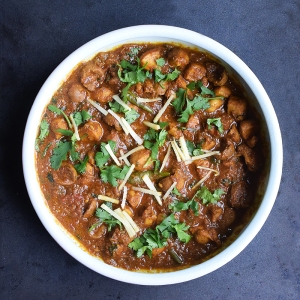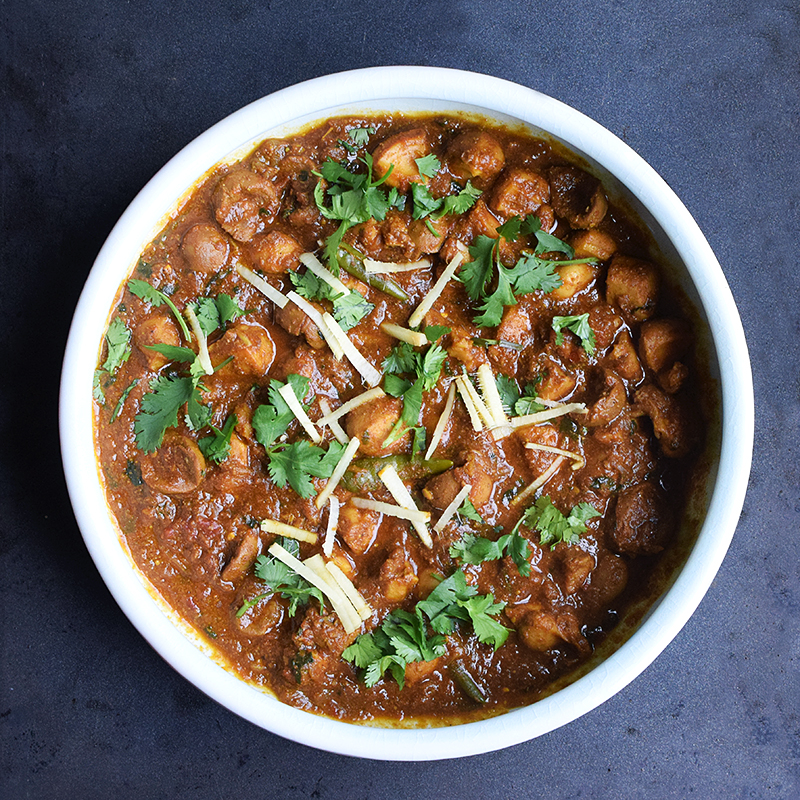
Here is the recipe for goat testicles and kidneys in a spicy sauce that you have been clamouring for. Some of you in the US will ask, “But where can we buy goat testicles and kidneys?!” What am I, your fucking personal shopper? Look in grocery stores catering to goat-eating cultures. For my part I got the testicles and kidneys used in this recipe from the goat friends and we bought from a local farm at the end of December and had cut up to our specifications. I asked if the testicles could be saved by the processor and they could and I got ’em. Now you may not associate Indian food with the cooking of offal. But liver and kidney are very commonly eaten, be they of chickens or goats. They were always included in the chicken and goat curries cooked at home when I was growing up as were dishes centered entirely on liver. My mother did not, however, cook goat testicles. But we ate them in dhabas in Delhi, along with things like brain curry (a particular treat on my 13th birthday at Kake da Hotel in Connaught Place). In Punjabi cooking these are not particularly exotic items. And nor are they anything very exotic on the plate. Goat testicles, in particular, have a very mild flavour and a pleasant spongy texture; perfect for coating in a spicy masala and that is what I do here. Please keep in mind that mine is not a traditional Punjabi recipe—it may resemble one in some ways but doubtless departs from most in others.
Ingredients
- 1 lb goat testicles, cut into small chunks
- 1/2 lb goat kidneys, cut into small chunks
- 1 large onion, thinly sliced
- 2 large cloves of garlic and about as much ginger roughly crushed
- The following ground masala:
- 2 tspns coriander powder
- 1 tspn cumin powder
- 1/2 tspn methi/fenugreek seed powder
- 1 tblspn garam masala
- 1 heaped tspn hot chilli powder
- 1/2 tspn haldi/turmeric powder
- 1/2 tspn jaggery/dark brown sugar
- 1 cup crushed tomato
- 4-5 Thai chillies, slit
- 3 tblspns chopped dhania/cilantro leaves and stems
- 1 cup water off the boil
- Salt
- 1 tblspn ghee or neutral oil of choice
- 1 tblspn chopped dhania/cilantro leaves for garnish
- 1 tspn peeled and julienned ginger for garnish
Preparation
- Heat the ghee over medium heat in a large skillet/saute pan.
- Add the onion and saute till nicely browned.
- Add the crushed ginger-garlic and saute for another minute or till the raw aroma is gone.
- Add the chopped testicles and kidneys, mix in and saute till the colour changes and they release a lot of liquid.
- Add all the ground masalas, the jaggery and the salt, mix in and saute for another minute or two, stirring constantly.
- Add the crushed tomato and saute, stirring all the while till the tomato has completely broken down and oil begins to separate.
- Add the chopped dhania leaves and stems and the green chillies, mix in, cover the pan and cook on low heat for 15-20 minutes.
- Uncover and stir. The masala should be thick but not sticking to the pan.
- Add the hot water, mix in and simmer for another 5-7 minutes or till the gravy is at your preferred consistency.
- Garnish with the remaining chopped dhania leaves and the julienned ginger and serve with chapatis or parathas.
Notes
- Gurda=kidney; kapoora=testicles
- I like this—and most dishes involving kidneys or liver—to be quite spicy but you can dial it down as you prefer by using a milder chilli powder or fewer green chillies.
- I think the done thing is to remove the silver skin on the testicles but I don’t bother and no one ever notices.
- If you have access to kidneys but not testicles you could make this with only kidneys as well.
- Yes, yes, there’s a Reel of this being made on Instagram as well.
- Cooked in a much drier style the testicle-kidney duo makes a great drinking accompaniment as well.
- I have only encountered preps of testicles in Punjabi cooking. If you know of them being cooked in other Indian communities/cuisines please write in below.

